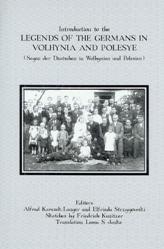
Introductions to the Legends of the Germans in Volhynia and Polesye
Introduction to the Legends of the Germans in Volhynia and Polesye
Editors – Alfred Karasek-Langer & Elfrieda Strzygowski
Sketches by Friedrich Kunitzer
Translated by Leona Janke, 2010
Leipzig
1938
Softcover, 80 pages
From the early 1800’s until WW II Volhynia was a melting pot of ethnic Germans. Cultural history research (mostly done 1925 through 1926) resulted in this volume of over 900 legends. Information gleaned from this research made it possible to determine background material about these people. This background information was included in the Introduction and was the impetus for this translation. Most legends mentioned are translated and included at the end.
Translators Notes:
Volhynia (“Wolhynien”, “Wolynski Gubernia”): At one time a governmental district in Southwestern Russia. Today it is in the Northwest Ukraine.
Polesye (“Polesien”): A geographical area along the Southern Belorussian and Northern Volhynian borders; sometimes referred to as the Pripet Marshes.
Colonists: Hugo Schmidt points out in “Die Evangelisch Lutherischne Kirche in Wolhynien” that a German community was referred to as a colony (“Kolonie”). “This often led to a misunderstanding in the case of German visitors. Earlier the word colony had to do with the German government’s overseas colonies. Not only that, but after 1886 there was a governmental migration committee whose only duty was to settle German farmers in Posen and West Prussia districts. These settlements were also called colonies. From this fact arose the misunderstanding, that in some way the Volhynian settlements were being sponsored by the German government.” In reality private initiative was the primary reason for the Volhynian immigration of Germans. It was promoted by advertising of Volhynian nobles who needed help on their estates. The Czars officials continued to refer to the German settlements as colonies.
“Hollaender”, Holland, and sometimes “Hauland”: “This term was commonly used in the 18th century down to the Partitions [of Poland] to denote German villages founded in Poland” according to Prof. Dr. Walter Kuhn, (Eastern Germany- a handbook edited by the Goettingen Research Committee), in the late 1500’s Dutchmen immigrated into the marshland area of the Vistula-Nogat delta, and successfully dealt with drainage problems. Low-lying lands became valuable and the “Dutchmen’s” services were engaged by the noble landlords who owned the land. The Dutchmen adopted the Low German vernacular and the High German written language while the Germans adopted their democratic organization of community and special forms of settlement.
“Marschhufendorf” (marsh-hide village):
A settlement style in which each house had its own plot of land which stretched out in a single, dead-straight, enclosed strip into the protected interior of the marsh. (One hide equaled 60 acres.)
$10Members save $5.00!
Become a member
207 in stock
